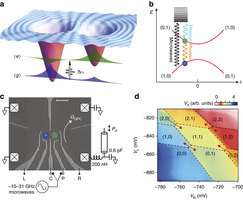Probing the sound of a quantum dot

(Phys.org) —Physicists at the University of Sydney have discovered a method of using microwaves to probe the sounds of a quantum dot, a promising platform for building a quantum computer.
The findings have been published in Nature Communications today.
A quantum dot consists of a small number of electrons trapped in zero dimensions inside a solid. The quantum mechanical properties of these electrons can be used to store and manipulate quantum data for revolutionary applications in computing, communication, sensing and bio-medical diagnostic applications.
James Colless and Xanthe Croot, PhD candidates in the University's School of Physics, uncovered a way to study what happens when electrons in quantum dots interact with sound waves of the solid they are trapped in.
"The possibility of computing using quantum logic, rather than the classical logic on which today's machines are based, has changed the boundary between hard and easy problems. Previously it was thought that certain tasks - exactly modeling a complex molecule to construct new medicines or computing certain mathematical functions - were simply too hard for any computer, no matter how big," said Professor David Reilly, from the Centre of Excellence for Engineered Quantum Systems (EQuS) and the University's School of Physics.
"The rules of the game have now changed. We now know that quantum mechanics allows certain interesting problems to be computed with ease, so long as you can build a machine that operates according to quantum mechanics - a daunting task!"
"Our work is a further step towards understanding the issues that enable or disable quantum machines. Sound waves in solids are a key mechanism that can lead to quantum devices interacting with their environment."
These sounds waves are called phonons, and are similar to the waves one can make in a stretched slinky. The 'slinky chain', in this case, is formed by the atoms which make up the solid. It turns out that interactions between sound waves and electrons reveal information about the environment of the electron - akin to detecting the size and shape of a room by listening to a singer's voice in that room.
The interaction between quantum dots and the solids in which they form is a double-edged sword for the purpose of quantum computing. On one hand, sound vibrations have been used to 'shuttle' electrons from place to place in quantum circuits - almost like a wave might pick up a surfer and take them into the beach.
"However, there are other contexts where sound interacting with electrons can cause huge problems: in particular, when you are performing a quantum algorithm and only want the electron to interact with certain parameters that the experimenter controls," said Xanthe Croot.
Unwanted sound can significantly limit the time you have to perform the algorithm before the electron loses all the information it was storing. Understanding how the size and geometry of the quantum circuit affects these interactions is therefore extremely important.
In quantum computing, different configurations of electrons within the dot represent something similar to the 0 and 1 (or on and off) states in classical computing. The 1 and the 0 states have different energies: if you apply microwaves with exactly this energy difference you can change the state from 0 to 1 and vice versa.
"We found that if you apply microwaves with energy slightly higher than the electron energy difference, the system creates sound of a very specific frequency. It is almost like the electron saying, if you hit me too hard I'll scream," said Ms Croot.
"Changing the microwave energy will change the frequency of the sound that the system creates in the solid. The results show that some frequencies of sound interact very strongly with the system, while others less so. There are hints in the data that the geometry of the quantum dot plays a key role in determining which frequencies will interact strongly."
More information:
"Raman phonon emission in a driven double quantum dot." J.I. Colless, et al. Nature Communications 5, Article number: 3716 DOI: 10.1038/ncomms4716
Received 15 February 2014 Accepted 20 March 2014 Published 23 April 2014
Journal information: Nature Communications
Provided by University of Sydney





















